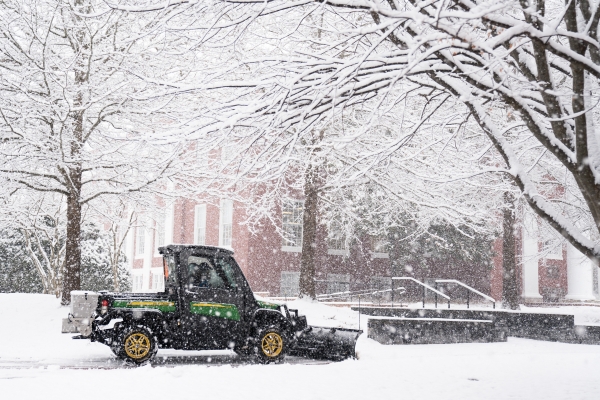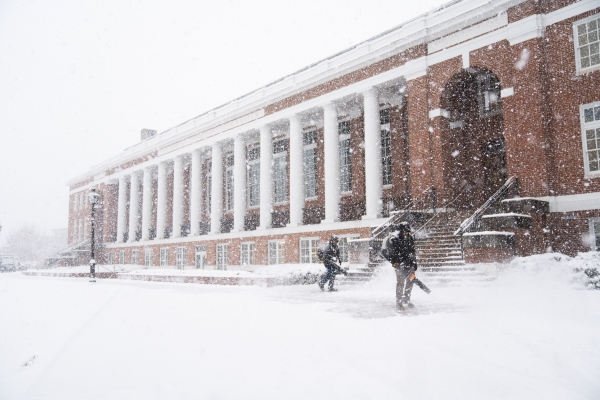Winter Watch University Facilities is at the ready to respond to wintry weather.
The winter weather in the Shenandoah Valley is a far cry from the deluge of wintry conditions typically experienced in northern regions of the United States, but that doesn’t mean the occasional storm doesn’t bring with it the same challenges.
During the first half of Winter Term, three significant weather events have brought a substantial mix of ice and snow to the Lexington area, posing challenges to normal campus operations. While the campus community considers how best to carry on despite the inconveniences, the ability to do so is often determined by the preparation and hard work of the University Facilities staff.
University Facilities maintains a detailed inclement weather plan that is reviewed and revised annually in preparation for the winter months. The plan includes a series of protocols that ensure clear communication between facilities leadership, the university administration and the facilities staff on the ground.
“The process starts by monitoring the 10-day forecast to determine if there are snow or icing events on the horizon,” said Tracy Huffer, director of operations and maintenance for the university. “When the forecast calls for inclement weather, we start discussing it immediately to ensure that the materials are ready and our vehicles are fueled and properly equipped in the event of a power outage.”
In the 48 hours before the weather event, Huffer meets with his leadership team, comprised of Grounds Supervisor Kathleen Black and Senior Lead Groundskeeper Keith Moore. Together, they prepare a plan based on the latest forecast models. Once a plan has been determined, the rest of the facilities supervisor team is brought in to discuss implementation.
“In this area, forecasts can change hourly, so we can only prepare so much,” said Huffer. “We are always monitoring the conditions and I stay in touch with Kathleen and Keith throughout to make sure we are on top of everything.”
Understanding the type of conditions that are expected plays a huge role in how the team approaches its objective. For instance, responding to freezing rain, sleet and ice require different strategies than snow removal. Additionally, the difference between powdery snow and wet, heavy snow can often determine which equipment is needed to clear walkways.
“If we are expecting ice, we can pre-treat areas with liquid de-icer the evening before the storm hits,” said Black, “If we’re dealing with snow, we would work to clear the snow before applying salt to help melt the icy areas.”
Great care is taken in selecting the materials used to melt the ice and provide traction on the different walkways and road surfaces made of asphalt, concrete, slate and brick around campus.
“The University Chapel parking lot is comprised of brick and we want to make sure we aren’t ruining that surface by the materials we use,” said Moore. “We can’t use salt on the bricks because it will degrade the sand base that lies beneath them. On slate walkways in other areas of campus, such as in front of Elrod Commons, we use blades with rubber guards on them when we plow to ensure we don’t chip the surface.”
Black also noted that while salt works great for melting snow, it’s not the best choice for every surface.
“Salt also tends to eat away at concrete, so we use a de-icer product called Entry, which is chloride-free and is safe for pets – it won’t harm their paws,” said Black. “We also use a snow melt product which is 100% magnesium and is less corrosive than salt.”
University Facilities maintains a robust fleet of vehicles that can move and remove snow when necessary. Trucks, tractors and rugged terrain vehicles (RTVs) are fitted with snowplows to clear snow from roadways and select sidewalks, while snowblowers are used on many walkways. For light powdery snow, backpack blowers are also employed to keep walkways clear. Good old-fashioned “elbow grease” is also used in the form of the traditional snow shovel.
The entire University Facilities team, numbering approximately 110 essential employees, is involved in response to a winter storm, with various trade shops and grounds crews being responsible for specific areas of campus. The entire operation includes facilities, Public Safety, custodial staff and even the athletics ground crew.
“Our top priority is to clear the pathways between student housing and the dining facilities,” said Huffer. “As we progress through the various areas, we will dismiss various campus partners from the process, but the grounds crew is generally on staff and on-call throughout the weather event.”
Constant meetings are held in anticipation of potential pivots depending on the forecast. All the while, Huffer is in communication with the Provost’s Office about ground conditions around campus to help inform the administration’s decisions about late opening, early dismissal or the occasional closure.
Even after the roadways, parking lots and sidewalks have been cleared, the grounds crew must remain vigilant until the last of the winter precipitation has melted and evaporated.
“We will keep monitoring conditions to ensure they are safe,” said Huffer. “When you have warming during the day and freezing at night, this transition can create black ice on surfaces and icicles that hang from roofs and can drop on people. And when it warms, sometimes snow can slide off roofs and onto sidewalks which can then refreeze.”
It has been several years since the Washington and Lee campus has experienced as many significant winter weather events as we’ve seen so far in 2025, and Huffer noted that has posed some challenges. Like many large departments on campus, facilities has added several new members to its workforce and with the lack of measurable snowfall in recent years, there haven’t been many opportunities to put the inclement weather plan in action. The frequent storms battering the East Coast this winter have also created a shortage in salt stockpiles.
“We’ve gone through quite a bit of salt ourselves, but we have a great partnership with City of Lexington, particularly Deputy Director Scott Dameron,” said Huffer. “We have been able to get a lot of our road salt from the city and they have been great about helping us get the resources we need.”
While spring is just around the corner, W&L’s University Facilities team is at the ready and available to work around the clock to ensure the campus community remains safe should another winter storm present challenges.
By the Numbers
6 – The average winter snow/ice accumulation in inches over the previous five years
22 – Approximation of the snow/ice accumulation in inches in Lexington for Winter 2024-25 to date
1 – Number of rugged terrain vehicles outfitted with a salt spreader used by University Facilities
1 – Number of Bobcat equipment used by University Facilities for snow removal
5 – Number of trucks used by University Facilities for snow removal
8 – Number of tractors used by University Facilities for snow removal
25 – Gallons of liquid de-icer used by University Facilities this winter
458 – Estimated bags of salt used by University Facilities this winter
20,610 – The estimated weight in pounds of the salt used by University Facilities this winter (Does not include the road salt used on parking lots)
110 – Estimated number of University Facilities staff who assist with inclement weather cleanup during a storm event
 University Facilities plows during a recent snowfall in February.
University Facilities plows during a recent snowfall in February. University Facilities workers use blowers to clear snow during a February storm
University Facilities workers use blowers to clear snow during a February storm
You must be logged in to post a comment.